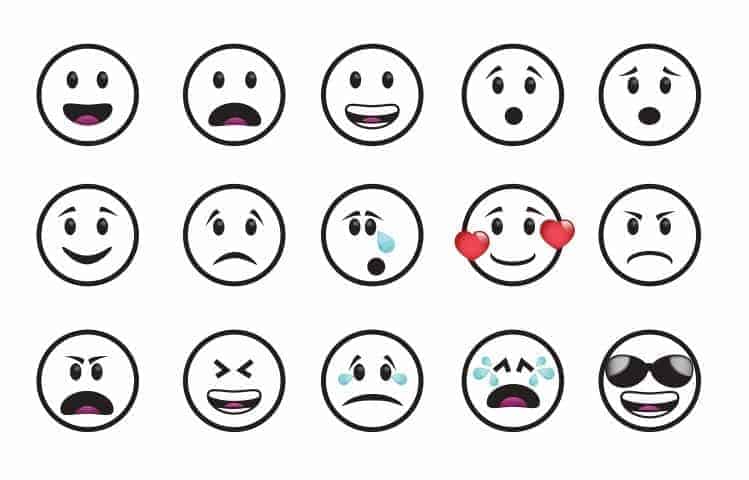Blog
The Fine Line, Emojis and Your Company
In business, we all know that there is a fine line in between casual and informal when developing emails to coworkers and customers. To further blur this line we now also have to consider the inclusion of emoticons or emojis in emails and headers to loosen up our emails. Emoticons are font based representations of emotions, while emoji are the graphic representation and are widely popular. Not only are they cute but they help represent our feeling and convey our tones. Sometimes they help punctuate excitement, clarify a joke, or even used in advertisements. However, we also don’t want to come off as unprofessional, especially in emails to our potential customers. So how and when do we walk the fine line? In this article we will cover the proper use of emojis in your company and when and why you should attempt to use them.
Unfortunately, for those of us who do not operate in the emoticon world, learning how to use them can often feel like learning a whole new language. This new language is riddled with oops moments and accidental winky faces being perceived in a negative way. We have a few do’s and don’ts to consider before you jump straight into composing your first workplace email. The first few do’s all have to do with being authentic in your emails, which is a good start for any email. Don’t use the emoticon or emoji unless it actually expresses your emotion. A lot of business is now done virtually where you can spend years without actually meeting a coworker that you talk to daily. Adding a smiley face to a simple “yes” response can make your connection more personable. If you are just starting out in the world of emojis, stick to ones you can clearly identify, if you are not sure what the little face means, simply don’t send it. Stick with clapping hands or the 100 emoji and try to stay positive. While they are becoming more popular, still try to keep them out of formal emails, or business emails that are being sent to many employees you don’t know. They can be read negatively and informally. What may seem like an easy don’t but is somewhat overlooked, do not use emojis in highly formal emails, especially those involved in terminating a contract or answering a negative customer complaint. Emojis in these situations can be read as both informal and inappropriate. Our last do to this section is to set a standard with you and your employees or coworkers. Your emojis should not replace whole sentences or ideas, also you do not want to end up with 10 emojis in a row. Set a standard of appropriate use and try to limit the amount of emojis used, especially when they are sent to customers.
So now that we have a few guidelines of how to use an emoji, why should we use them in our professional lives? More and more young customers and employees are reading emails, advertisements, and messages without emojis or emoticons as negative. Or they will not become quite as engaged without the well-known smiles and familiar thumbs up. Even if you personally can’t stand them, many of your coworkers and employees use them in their everyday interaction and have learned to use them as ways to interpret a message. If you are sending an advertisement via email, your customers might be more responsive with a few excited emojis scattered amongst the message. Having these emoji also creates a more personal and human connection to you and your company. Almost 41% of workers in the United States are using emojis in their emails, and it is a growing trend. As of now, you can send out big professional emails to your company without using and emojis, but when talking to employees you know personally, you may see the text scattered with thumbs up or perplexed faces. When determining if it is appropriate to add an emoji into your email consider three things: age, gender, and culture. While most of us believe that emojis are for text messages between millennials, there is a bulk of research that show that older generations are also likely to use and enjoy emoticons. In addition, research has also shown us that on average women are more likely to use emoticons and emojis in their written communications to express emotions. Finally, what is your work culture like? Does it seem appropriate to be sending a message with emojis in your workplace? If the answer is a hesitant no, perhaps wait on sending a thumb up. Worst case scenario, wait until someone in a higher up position uses an emoji.
How and why are not the only aspects to figuring out this new way of communication sneaking into our professional settings, you also need to determine when. We’ve touched briefly on a few options, but to more directly cover the topic we will lay out best practices. There are more than 2 billion users of social media, meaning that they are interpreting, reading, and writing emoji-filled messages almost every day. If you are sending out advertisements via social media, or even in email, consider adding emojis that convey your company’s excitement about its products. More personal and human-like advertisements will allow your customers to easily connect and interpret the material they are reading. It will make your company appear more youthful and exciting with the simple expression of emojis. In business settings, limit your emoji use to people you know, and have a relationship will. Perhaps in the future, even more, traditional businesses will be adding emojis into all emails, but for now, stick with personal interactions and limit the amount you use.
It can be a bit anxiety-inducing to be the first one to type an emoji to your boss or your coworker. In today’s business world there is a fine line between professional emojis and overdoing it a bit with your enthusiasm. Stick with emojis that you know, and send it to people that you have a pre-established relationship with. Today, whether we like emojis or not, they are integral parts of communication that allow us to express our thoughts and feelings to each other. Using them can help open you up to new customers and create better business relationships.





